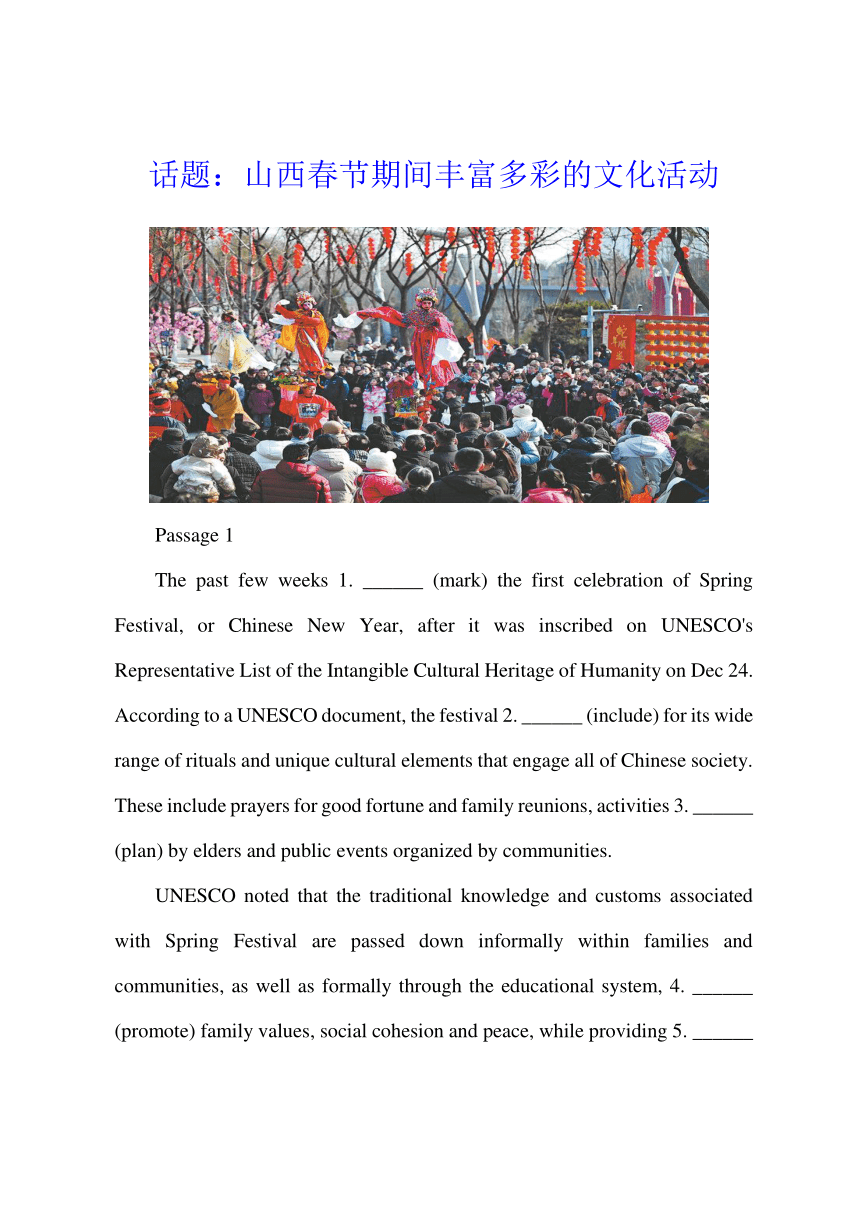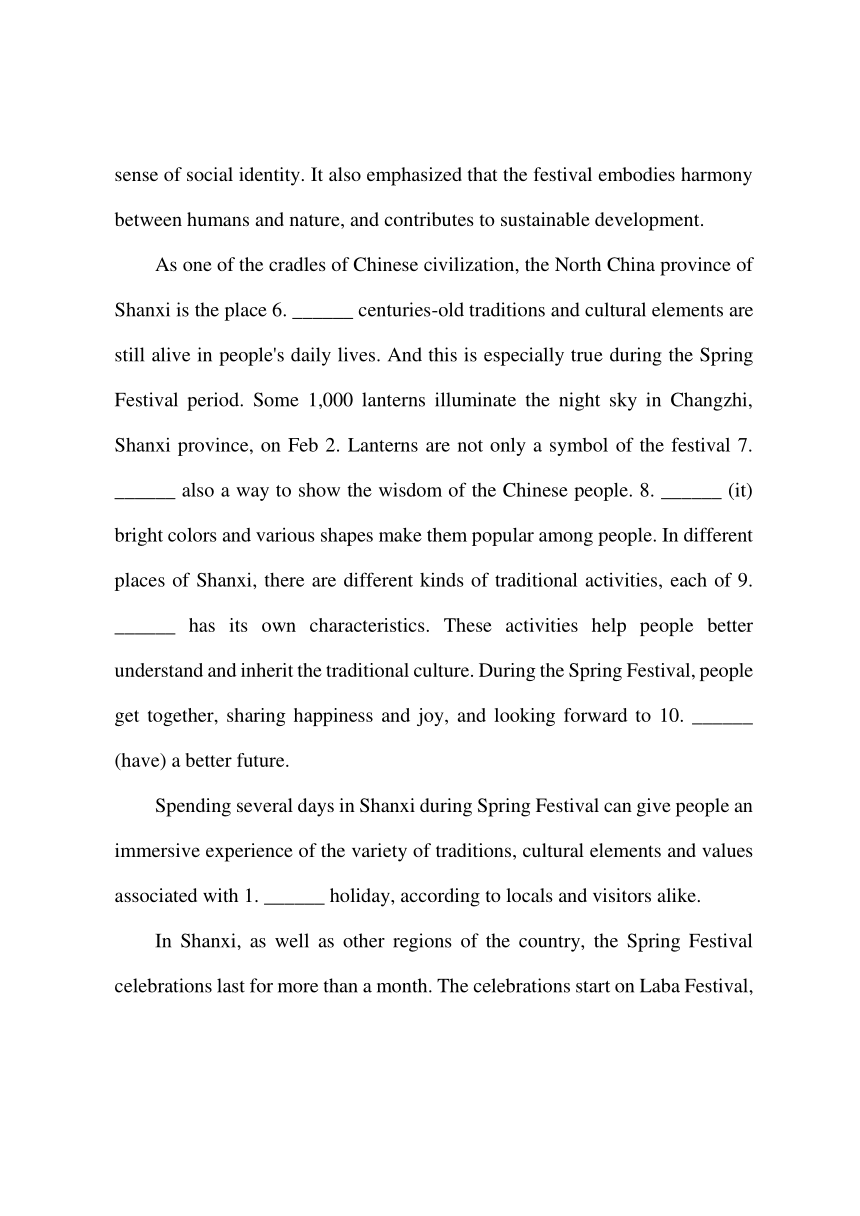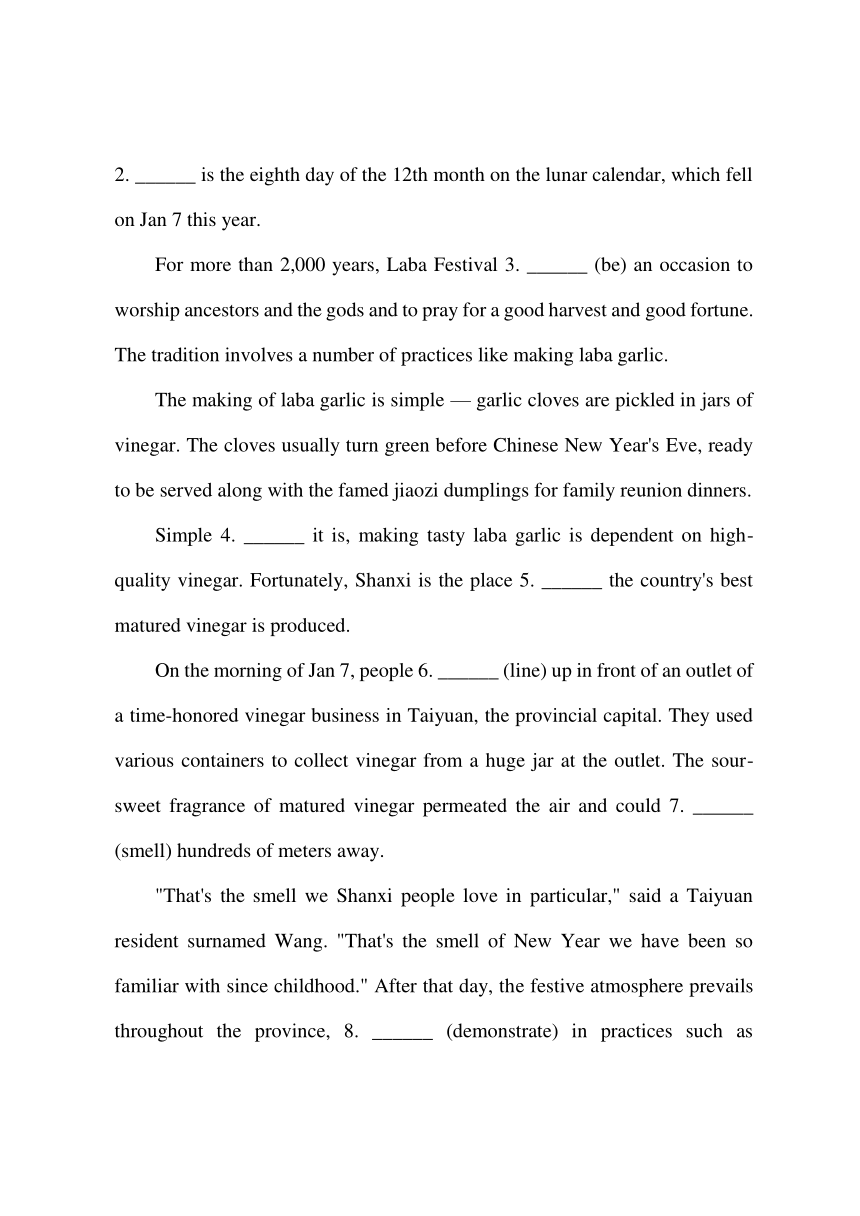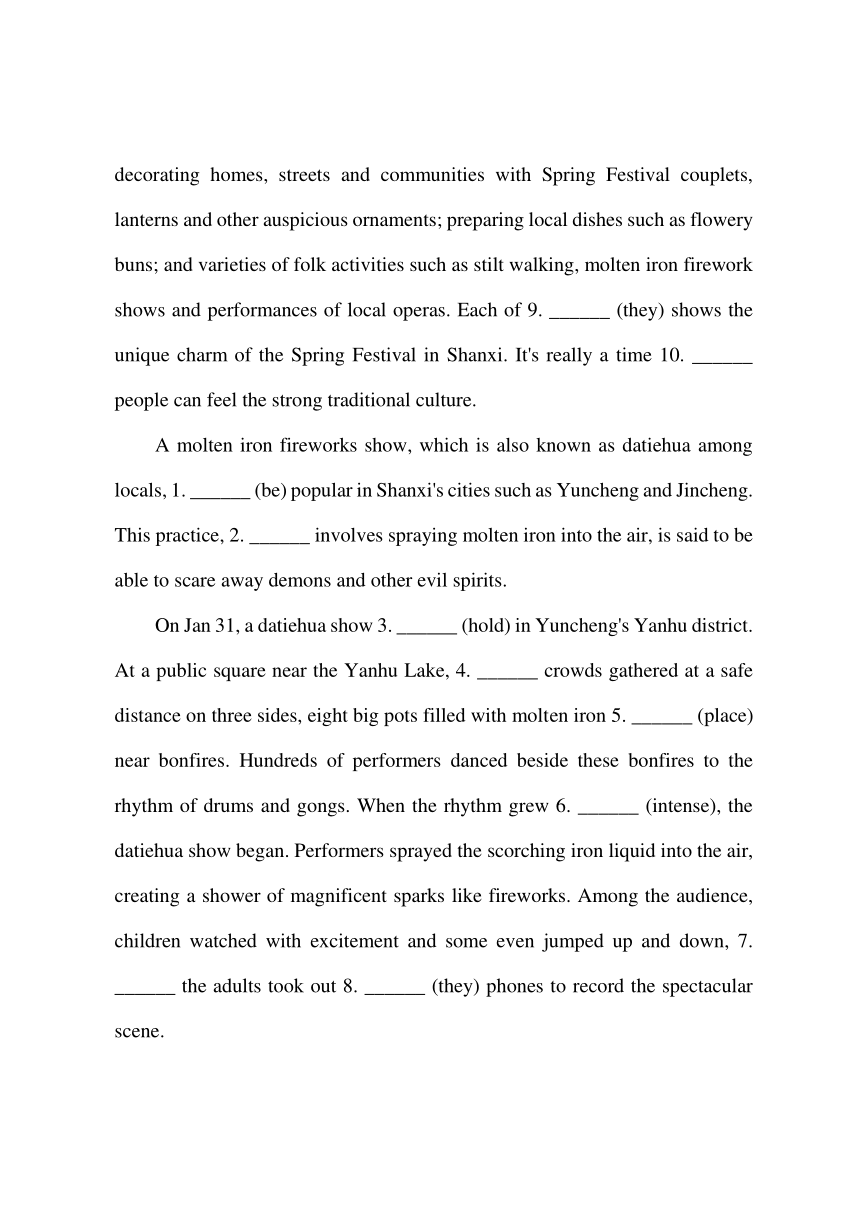2025届高三英语二轮复习:时事热点 语法填空 山西春节期间丰富多彩的文化活动 专项训练(含解析)
文档属性
| 名称 | 2025届高三英语二轮复习:时事热点 语法填空 山西春节期间丰富多彩的文化活动 专项训练(含解析) |  | |
| 格式 | docx | ||
| 文件大小 | 1.0MB | ||
| 资源类型 | 教案 | ||
| 版本资源 | 人教版(2019) | ||
| 科目 | 英语 | ||
| 更新时间 | 2025-02-13 11:31:03 | ||
图片预览




文档简介
话题:山西春节期间丰富多彩的文化活动
Passage 1
The past few weeks 1. ______ (mark) the first celebration of Spring Festival, or Chinese New Year, after it was inscribed on UNESCO's Representative List of the Intangible Cultural Heritage of Humanity on Dec 24. According to a UNESCO document, the festival 2. ______ (include) for its wide range of rituals and unique cultural elements that engage all of Chinese society. These include prayers for good fortune and family reunions, activities 3. ______ (plan) by elders and public events organized by communities.
UNESCO noted that the traditional knowledge and customs associated with Spring Festival are passed down informally within families and communities, as well as formally through the educational system, 4. ______ (promote) family values, social cohesion and peace, while providing 5. ______ sense of social identity. It also emphasized that the festival embodies harmony between humans and nature, and contributes to sustainable development.
As one of the cradles of Chinese civilization, the North China province of Shanxi is the place 6. ______ centuries-old traditions and cultural elements are still alive in people's daily lives. And this is especially true during the Spring Festival period. Some 1,000 lanterns illuminate the night sky in Changzhi, Shanxi province, on Feb 2. Lanterns are not only a symbol of the festival 7. ______ also a way to show the wisdom of the Chinese people. 8. ______ (it) bright colors and various shapes make them popular among people. In different places of Shanxi, there are different kinds of traditional activities, each of 9. ______ has its own characteristics. These activities help people better understand and inherit the traditional culture. During the Spring Festival, people get together, sharing happiness and joy, and looking forward to 10. ______ (have) a better future.
Spending several days in Shanxi during Spring Festival can give people an immersive experience of the variety of traditions, cultural elements and values associated with 1. ______ holiday, according to locals and visitors alike.
In Shanxi, as well as other regions of the country, the Spring Festival celebrations last for more than a month. The celebrations start on Laba Festival, 2. ______ is the eighth day of the 12th month on the lunar calendar, which fell on Jan 7 this year.
For more than 2,000 years, Laba Festival 3. ______ (be) an occasion to worship ancestors and the gods and to pray for a good harvest and good fortune. The tradition involves a number of practices like making laba garlic.
The making of laba garlic is simple — garlic cloves are pickled in jars of vinegar. The cloves usually turn green before Chinese New Year's Eve, ready to be served along with the famed jiaozi dumplings for family reunion dinners.
Simple 4. ______ it is, making tasty laba garlic is dependent on high-quality vinegar. Fortunately, Shanxi is the place 5. ______ the country's best matured vinegar is produced.
On the morning of Jan 7, people 6. ______ (line) up in front of an outlet of a time-honored vinegar business in Taiyuan, the provincial capital. They used various containers to collect vinegar from a huge jar at the outlet. The sour-sweet fragrance of matured vinegar permeated the air and could 7. ______ (smell) hundreds of meters away.
"That's the smell we Shanxi people love in particular," said a Taiyuan resident surnamed Wang. "That's the smell of New Year we have been so familiar with since childhood." After that day, the festive atmosphere prevails throughout the province, 8. ______ (demonstrate) in practices such as decorating homes, streets and communities with Spring Festival couplets, lanterns and other auspicious ornaments; preparing local dishes such as flowery buns; and varieties of folk activities such as stilt walking, molten iron firework shows and performances of local operas. Each of 9. ______ (they) shows the unique charm of the Spring Festival in Shanxi. It's really a time 10. ______ people can feel the strong traditional culture.
A molten iron fireworks show, which is also known as datiehua among locals, 1. ______ (be) popular in Shanxi's cities such as Yuncheng and Jincheng. This practice, 2. ______ involves spraying molten iron into the air, is said to be able to scare away demons and other evil spirits.
On Jan 31, a datiehua show 3. ______ (hold) in Yuncheng's Yanhu district. At a public square near the Yanhu Lake, 4. ______ crowds gathered at a safe distance on three sides, eight big pots filled with molten iron 5. ______ (place) near bonfires. Hundreds of performers danced beside these bonfires to the rhythm of drums and gongs. When the rhythm grew 6. ______ (intense), the datiehua show began. Performers sprayed the scorching iron liquid into the air, creating a shower of magnificent sparks like fireworks. Among the audience, children watched with excitement and some even jumped up and down, 7. ______ the adults took out 8. ______ (they) phones to record the spectacular scene.
Shanxi, as one of the origins of the country's opera arts, 9. ______ (dub) "a cradle of Chinese operas". During Spring Festival, there are numerous opera shows across the province. On Jan 30, the main stage for the CCTV Spring Festival opera evening gala was set in the old county seat of Taiyuan. Renowned performers of various local operas, such as Jinju Opera, Puju Opera, Shangdang Bangzi and Beilu Bangzi, offered a wonderful audiovisual experience to audiences nationwide. Moreover, Shanxi boasts 182 national-level intangible cultural heritage items and 942 provincial-level ICH items. Most of these cultural treasures were displayed to the public through different shows during this Spring Festival, making it a time 10. ______ people can fully experience the charm of Shanxi's cultural heritage.
Passage1
答案:
have marked(根据时间状语 The past few weeks,用现在完成时)
is included(festival 和 include 是被动关系,用一般现在时的被动语态)
planned(activities 和 plan 是被动关系,用过去分词作后置定语)
promoting(现在分词作结果状语)
a(固定短语 a sense of)
where(先行词是 place,在定语从句中作地点状语,用 where)
but(not only...but also... 固定搭配)
Their(修饰名词 colors,用形容词性物主代词)
which(引导非限制性定语从句,先行词是 activities)
having(look forward to doing sth. 期待做某事)
Passage2
答案:
the(特指春节这个节日,用定冠词 the)
which(引导非限制性定语从句,先行词是 Laba Festival,在从句中作主语)
has been(根据时间状语 For more than 2,000 years,用现在完成时)
as(as 引导让步状语从句,表语提前,构成部分倒装)
where(先行词是 place,在定语从句中作地点状语,用 where)
lined(根据时间状语 On the morning of Jan 7,用一般过去时)
be smelt(vinegar 和 smell 是被动关系,could 后接动词原形,所以用 be smelt)
demonstrated(过去分词作后置定语,修饰 atmosphere,表被动)
them(of 是介词,后接宾格代词 them)
when(先行词是 time,在定语从句中作时间状语,用 when)
Passage 3
答案:
is(主语 A molten iron fireworks show 为单数,陈述一般事实,用一般现在时的第三人称单数形式 is)
which(引导非限制性定语从句,先行词是 practice,在从句中作主语,用 which)
was held(根据时间状语 On Jan 31,且 show 与 hold 是被动关系,用一般过去时的被动语态 was held)
where(先行词是 public square,在从句中作地点状语,用 where 引导定语从句)
were placed(pots 与 place 是被动关系,根据语境用一般过去时的被动语态 were placed)
more intense(grow 在这里是系动词,后面接形容词,根据语境表示节奏变得更强烈,用比较级 more intense)
while(表示前后对比,孩子们兴奋观看跳跃,而成年人拿出手机记录,用 while)
their(修饰名词 phones,用形容词性物主代词 their)
is dubbed(Shanxi 与 dub 是被动关系,陈述一般事实,用一般现在时的被动语态 is dubbed)
when(先行词是 time,在从句中作时间状语,用 when 引导定语从句)
Passage 1
The past few weeks 1. ______ (mark) the first celebration of Spring Festival, or Chinese New Year, after it was inscribed on UNESCO's Representative List of the Intangible Cultural Heritage of Humanity on Dec 24. According to a UNESCO document, the festival 2. ______ (include) for its wide range of rituals and unique cultural elements that engage all of Chinese society. These include prayers for good fortune and family reunions, activities 3. ______ (plan) by elders and public events organized by communities.
UNESCO noted that the traditional knowledge and customs associated with Spring Festival are passed down informally within families and communities, as well as formally through the educational system, 4. ______ (promote) family values, social cohesion and peace, while providing 5. ______ sense of social identity. It also emphasized that the festival embodies harmony between humans and nature, and contributes to sustainable development.
As one of the cradles of Chinese civilization, the North China province of Shanxi is the place 6. ______ centuries-old traditions and cultural elements are still alive in people's daily lives. And this is especially true during the Spring Festival period. Some 1,000 lanterns illuminate the night sky in Changzhi, Shanxi province, on Feb 2. Lanterns are not only a symbol of the festival 7. ______ also a way to show the wisdom of the Chinese people. 8. ______ (it) bright colors and various shapes make them popular among people. In different places of Shanxi, there are different kinds of traditional activities, each of 9. ______ has its own characteristics. These activities help people better understand and inherit the traditional culture. During the Spring Festival, people get together, sharing happiness and joy, and looking forward to 10. ______ (have) a better future.
Spending several days in Shanxi during Spring Festival can give people an immersive experience of the variety of traditions, cultural elements and values associated with 1. ______ holiday, according to locals and visitors alike.
In Shanxi, as well as other regions of the country, the Spring Festival celebrations last for more than a month. The celebrations start on Laba Festival, 2. ______ is the eighth day of the 12th month on the lunar calendar, which fell on Jan 7 this year.
For more than 2,000 years, Laba Festival 3. ______ (be) an occasion to worship ancestors and the gods and to pray for a good harvest and good fortune. The tradition involves a number of practices like making laba garlic.
The making of laba garlic is simple — garlic cloves are pickled in jars of vinegar. The cloves usually turn green before Chinese New Year's Eve, ready to be served along with the famed jiaozi dumplings for family reunion dinners.
Simple 4. ______ it is, making tasty laba garlic is dependent on high-quality vinegar. Fortunately, Shanxi is the place 5. ______ the country's best matured vinegar is produced.
On the morning of Jan 7, people 6. ______ (line) up in front of an outlet of a time-honored vinegar business in Taiyuan, the provincial capital. They used various containers to collect vinegar from a huge jar at the outlet. The sour-sweet fragrance of matured vinegar permeated the air and could 7. ______ (smell) hundreds of meters away.
"That's the smell we Shanxi people love in particular," said a Taiyuan resident surnamed Wang. "That's the smell of New Year we have been so familiar with since childhood." After that day, the festive atmosphere prevails throughout the province, 8. ______ (demonstrate) in practices such as decorating homes, streets and communities with Spring Festival couplets, lanterns and other auspicious ornaments; preparing local dishes such as flowery buns; and varieties of folk activities such as stilt walking, molten iron firework shows and performances of local operas. Each of 9. ______ (they) shows the unique charm of the Spring Festival in Shanxi. It's really a time 10. ______ people can feel the strong traditional culture.
A molten iron fireworks show, which is also known as datiehua among locals, 1. ______ (be) popular in Shanxi's cities such as Yuncheng and Jincheng. This practice, 2. ______ involves spraying molten iron into the air, is said to be able to scare away demons and other evil spirits.
On Jan 31, a datiehua show 3. ______ (hold) in Yuncheng's Yanhu district. At a public square near the Yanhu Lake, 4. ______ crowds gathered at a safe distance on three sides, eight big pots filled with molten iron 5. ______ (place) near bonfires. Hundreds of performers danced beside these bonfires to the rhythm of drums and gongs. When the rhythm grew 6. ______ (intense), the datiehua show began. Performers sprayed the scorching iron liquid into the air, creating a shower of magnificent sparks like fireworks. Among the audience, children watched with excitement and some even jumped up and down, 7. ______ the adults took out 8. ______ (they) phones to record the spectacular scene.
Shanxi, as one of the origins of the country's opera arts, 9. ______ (dub) "a cradle of Chinese operas". During Spring Festival, there are numerous opera shows across the province. On Jan 30, the main stage for the CCTV Spring Festival opera evening gala was set in the old county seat of Taiyuan. Renowned performers of various local operas, such as Jinju Opera, Puju Opera, Shangdang Bangzi and Beilu Bangzi, offered a wonderful audiovisual experience to audiences nationwide. Moreover, Shanxi boasts 182 national-level intangible cultural heritage items and 942 provincial-level ICH items. Most of these cultural treasures were displayed to the public through different shows during this Spring Festival, making it a time 10. ______ people can fully experience the charm of Shanxi's cultural heritage.
Passage1
答案:
have marked(根据时间状语 The past few weeks,用现在完成时)
is included(festival 和 include 是被动关系,用一般现在时的被动语态)
planned(activities 和 plan 是被动关系,用过去分词作后置定语)
promoting(现在分词作结果状语)
a(固定短语 a sense of)
where(先行词是 place,在定语从句中作地点状语,用 where)
but(not only...but also... 固定搭配)
Their(修饰名词 colors,用形容词性物主代词)
which(引导非限制性定语从句,先行词是 activities)
having(look forward to doing sth. 期待做某事)
Passage2
答案:
the(特指春节这个节日,用定冠词 the)
which(引导非限制性定语从句,先行词是 Laba Festival,在从句中作主语)
has been(根据时间状语 For more than 2,000 years,用现在完成时)
as(as 引导让步状语从句,表语提前,构成部分倒装)
where(先行词是 place,在定语从句中作地点状语,用 where)
lined(根据时间状语 On the morning of Jan 7,用一般过去时)
be smelt(vinegar 和 smell 是被动关系,could 后接动词原形,所以用 be smelt)
demonstrated(过去分词作后置定语,修饰 atmosphere,表被动)
them(of 是介词,后接宾格代词 them)
when(先行词是 time,在定语从句中作时间状语,用 when)
Passage 3
答案:
is(主语 A molten iron fireworks show 为单数,陈述一般事实,用一般现在时的第三人称单数形式 is)
which(引导非限制性定语从句,先行词是 practice,在从句中作主语,用 which)
was held(根据时间状语 On Jan 31,且 show 与 hold 是被动关系,用一般过去时的被动语态 was held)
where(先行词是 public square,在从句中作地点状语,用 where 引导定语从句)
were placed(pots 与 place 是被动关系,根据语境用一般过去时的被动语态 were placed)
more intense(grow 在这里是系动词,后面接形容词,根据语境表示节奏变得更强烈,用比较级 more intense)
while(表示前后对比,孩子们兴奋观看跳跃,而成年人拿出手机记录,用 while)
their(修饰名词 phones,用形容词性物主代词 their)
is dubbed(Shanxi 与 dub 是被动关系,陈述一般事实,用一般现在时的被动语态 is dubbed)
when(先行词是 time,在从句中作时间状语,用 when 引导定语从句)
